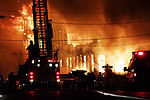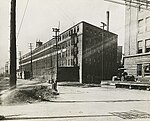Grand Rapids Swing Bridge
Buildings and structures in Grand Rapids, MichiganCSX Transportation bridgesPratt truss bridges in the United StatesRailroad bridges in MichiganSteel bridges in the United States ... and 3 more
Swing bridges in the United StatesTransportation buildings and structures in Kent County, MichiganTransportation in Grand Rapids, Michigan

The Grand Rapids Swing Bridge is a four span Pratt truss railroad swing bridge in Grand Rapids, Michigan. It was built in 1902 for the Pere Marquette Railroad as a swing bridge to allow steamboats to pass up the Grand River, but this river traffic was discontinued in 1907. The turntable is rusted shut and currently inoperable. Originally it was built as a double track bridge, but one set of tracks has been removed. The bridge itself is still in use, and carries an Amtrak train which runs from the Amtrak station just east of the bridge, as well as CSX freight trains. In crossing the Grand River, it touches the south end of a small island.
Excerpt from the Wikipedia article Grand Rapids Swing Bridge (License: CC BY-SA 3.0, Authors, Images).Grand Rapids Swing Bridge
Front Avenue Southwest, Grand Rapids
Geographical coordinates (GPS) Address External links Nearby Places Show on map
Geographical coordinates (GPS)
| Latitude | Longitude |
|---|---|
| N 42.958055555556 ° | E -85.680555555556 ° |
Address
Pere Marquette/C&O/CSX Railroad Bridge (Grand Rapids Swing Bridge)
Front Avenue Southwest
49504 Grand Rapids
Michigan, United States
Open on Google Maps








